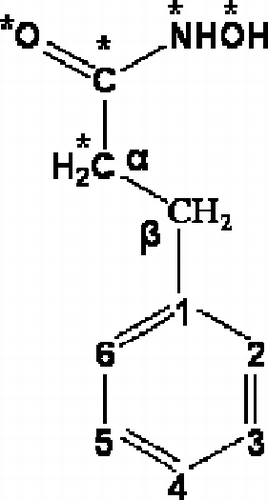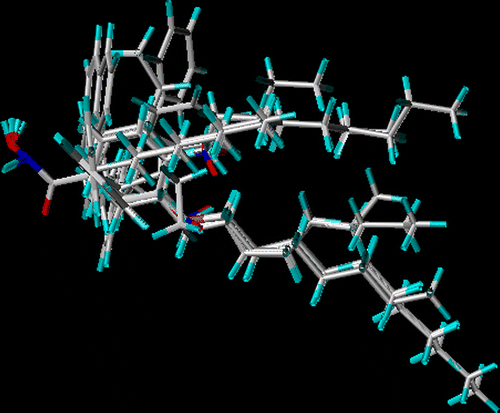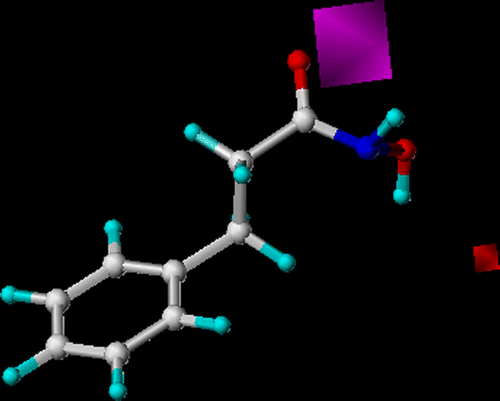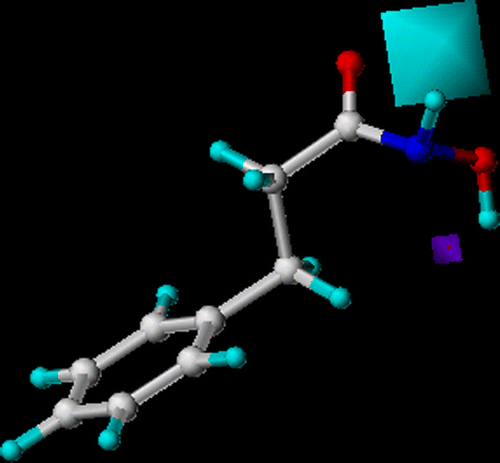Abstract
Urease (EC 3.5.1.5) serves as a virulence factor in pathogens that are responsible for the development of many diseases in humans and animals. Urease allows soil microorganisms to use urea as a source of nitrogen and aid in the rapid break down of urea-based fertilizers resulting in phytopathiCIT000y. It has been well established that hydroxamic acids are the potent inhibitors of urease activity. The 3D-QSAR studies on thirty five hydroxamic acid derivatives as known urease inhibitors were performed by Comparative Molecular Field Analysis (CoMFA) and Comparative Molecular Similarity Indices Analysis (CoMSIA) methods to determine the factors required for the activity of these compounds. The CoMFA model produced statistically significant results with cross-validated (q2) 0.532 and conventional (r2) correlation coefficients 0.969.The model indicated that the steric field (70.0%) has greater influence on hydroxamic acid inhibitors than the electrostatic field (30.0%). Furthermore, five different fields: steric, electrostatic, hydrophobic, H-bond donor and H-bond acceptor assumed to generate the CoMSIA model, which gave q2 0.665 and r2 0.976.This model showed that steric (43.0%), electrostatic (26.4%) and hydrophobic (20.3%) properties played a major role in urease inhibition. The analysis of CoMFA and CoMSIA contour maps provided insight into the possible modification of the hydroxamic acid derivatives for improved activity.
Introduction
The nickel containing enzyme, urease (urea amidohydrolases: E.C 3.5.1.5) catalyzes the rapid hydrolysis of urea to form ammonia and carbamate [Citation1]. The spontaneous decomposition of carbamate yields a second molecule of ammonia and carbon dioxide. High concentration of ammonia arising from these reactions, as well as the accompanying pH elevation, has negative side effects in agriculture Citation2–4 and health [Citation2,Citation5,Citation6]. For example, urease serves as a virulence factor in pathogens that are responsible for the development of kidney stones, pyelonephritis, peptic ulcers, and other medical complications [Citation6]. The activity of soil-derived urease rapidly degrades urea-based fertilizers, causing significant environmental and economic problems by releasing large amount of ammonia into the atmosphere during urea fertilization. This further contributes to phytopathic effect and loss of volatilized nitrogen [Citation7]. The enzyme also plays a critical role in the nitrogen metabolism of many microorganisms and plants [Citation6,Citation8]. Therefore, strategies based on urease inhibition are now seriously considered as the first line treatment for infections caused by urease-producing bacteria, to reduce environmental pollution and to enhance the efficiency of urea nitrogen uptake by plants.
Hydroxamic acid derivatives are highly potent and specific inhibitors of plant and bacterial urease activity [Citation9,Citation10]. Hydroxamic acid derivatives [R–CONH–OH, R–C (OH) = NOH] (HXA) characterized by a terminal hydroxyl amide (O = C–NHOH) functionality represent an important class of urease inhibitors. These inhibitors were reported by Kobashi et al. in 1962. Since 1962 a wide range of hydroxamic acids have been designed and examined against urease of plant and microbial origin, including Jack bean (JB), Clostridium sordelli, Escherichia coli, Morganella morganii, Proteus mirabilis (PM), Proteus vulgaris, Providenecia rettgeri, Staphylococcus aureus and Bacillus pasteuri (BP) Citation11–16.
In the present study, 3D-QSAR methods, CoMFA and CoMSIA, were applied to investigate the local physicochemical properties involved in the interaction between ligand and receptor. The widely used CoMFA (comparative molecular field analysis) calculates steric and electrostatic properties according to Lennard-Jones and Coulomb potentials [Citation17]. The powerful CoMSIA approach (comparative molecular similarity indices analysis) calculates similarity indices in the space surrounding each of the aligned molecules in the data set Citation18–20. CoMSIA is believed to be less affected by changes in molecular alignment and provides smooth and interpretable contour maps as result of employing Gaussian type distance dependence with the molecular similarity indices it uses [Citation18]. The information provided by the derived 3D-QSAR models from hydroxamic acid derivatives can be used for designing and synthesis of potent urease inhibitors.
Computational methods
Data set and molecular structures
The 3D-structures and associated biological activities pIC50 (log 1/IC50) of thirty five compounds () were taken from the literature [Citation21]. In the reported study Kobashi et al. investigated the correlation between the chemical structure and the inhibitory activities of hydroxamic acids and related compounds against sword bean urease. Seven out of thirty five compounds were randomly selected to form the external validation set while the remaining were used as training set for the construction of CoMFA and CoMSIA models.
Table I. Structure of the compounds 1–35 used for 3D-QSAR analyses.
The three dimensional structure of each ligand was modeled with the SYBYL 6.9 [Citation22] molecular modeling program (Tripos Associates, Saint Louis, MO) using the sketch approach. The fragment libraries in SYBYL database were used as building blocks for the construction of larger ones. Each structure was first energy minimized using the standard Tripos force field [Citation23] (Powell method and 0.05 Kcal/(molÅ) energy gradient convergence criteria) and electrostatic charges were calculated by the Gasteiger method [Citation24] implemented in SYBYL, running on AMD Athelon desktop server using SuSe 9.1 operating system.
Alignment
The molecular alignment and orientation is one of the most sensitive input areas in 3D-QSAR studies. The accuracy of the prediction of a CoMFA model and the reliability of the contour maps strongly depend on the structural coordinates of molecules to be aligned according to reasonable bioactive conformations. In the present study the most active compound 29 was selected as a template and the remaining molecules were super-imposed on them by atom-fit option in SYBYL. The structure of compound 29 and the atoms used for alignment is shown in and the aligned molecules are shown in .
CoMFA analysis
The aligned molecules (1–35) were placed in a three-dimensional grid (2 Å spacing) extending atleast 2 Å beyond the volumes of all investigated molecules. The van der Waals potential and Coulombic terms representing the steric and electrostatic fields respectively were calculated using standard Tripos force field. A distance-dependent dielectric constant of 1.0 was used. An sp3 carbon atom with +1.0 charges was used as a probe atom. The steric and electrostatic fields were truncated at ± 30.00 kcal/mol and the electrostatic fields were ignored at the lattice points with maximal steric interactions.
CoMSIA analysis
The molecular alignment was placed in a three-dimensional grid (2 Å spacing) similar to that of CoMFA analysis. CoMSIA differs from CoMFA in the implementation of the fields. It calculates steric and electrostatic fields, in addition to hydrophobic, H-bond donor, and H-bond acceptor fields, and it used Gaussian values. CoMSIA has better ability to visualize and interpret the obtained correlations in terms of field contributions.
An sp3 carbon was used as a probe atom with radius 1.0 Å and +1.0 charge with hydrophobiCIT000y of +1.0 and hydrogen bond donor and hydrogen bond acceptor properties of +1.0 was used to calculate steric, electrostatic, hydrophobic, hydrogen bond donor and acceptor fields.
Partial least square (PLS) analysis
CoMFA and CoMSIA descriptors were used as independent variables and pIC50 as the dependent variables in partial least squares (PLS) Citation25–27 regression analyses for the development of 3D-QSAR model, and cross-validation was performed using the leave-one-out method [Citation28,Citation29]. The cross-validated q2 that resulted in optimum number of components and lowest standard error of prediction were considered for further analysis. Final analyses were performed to calculate conventional (non-cross-validated) ![]() using optimum number of components obtained from cross-validation procedure.
using optimum number of components obtained from cross-validation procedure.
Results and discussion
Results of the CoMFA analysis
During the processes of model development and validation, we found that compound 28 did not fit to either training or test set compounds. This molecule was removed and further study was performed on the remaining 34 compounds. The results of CoMFA by PLS analysis derived from training set compounds are summarized in which shows that a CoMFA model with a cross-validated q2 of 0.532 for six components was obtained. The non-cross-validated PLS analysis with the optimum components of 6 (N = 6) revealed a conventional r2 value of 0.969, F = 103.996, and an estimated standard error of 0.117. The steric field descriptors explain 70.0% of the variance, while the electrostatic descriptors explain 30.0%. These steric and electrostatic contribution results supported the previously published results [Citation30] that the effect of electronic character of substituents have less contribution in inhibitory activities. The predicted activities, the experimental activities and their residual for the training and test sets compounds are listed in . The table demonstrates that the predicted activities by the constructed CoMFA model are in good agreement with the experimental data, suggesting that the CoMFA model should have a satisfactory predictive ability.
Table II. summary Of Comfa And Comsia Results.
Table III. Actual and predicted inhibitory activities by CoMFA and CoMSIA analyses.
Results of the CoMSIA analysis
The results of CoMSIA analysis for the training set molecules were presented in . This model gave cross-validated correlation coefficient q2 = 0.665 with 6 number of components (N = 6), a non-cross-validated r2 of 0.976 with 43.0% steric, 26.4% electrostatic, 20.3% hydrophobic, 6.2% hydrogen bond donor and 4.2% hydrogen bond acceptor contributions. The actual inhibitory activities (pCI50), the calculated activities, predicted by the CoMSIA and their residuals for the training and test sets are given in . These results demonstrate that the CoMSIA model also provide a good predictive value.
CoMFA contour maps
The QSAR produced by CoMFA, with its hundreds or thousands of terms, was usually represented as 3-D ‘coefficient contour’. It shows regions where variations of steric or electrostatic nature in the structural features of different molecules contained in the training set lead to enhancement or reduction in the activity. The CoMFA contour plots of steric and electrostatic interaction are shown in . The most active compound 29 was used in the background. Sterically favored (green) regions were found near C3 and C4 of phenyl ring and extending to the alpha-carbon of the reference compound where bulkier substituent may increase activity. Two sterically unfavorable (yellow) contours were found one above C6 of phenyl ring and the other away from the phenyl ring where the bulkier substituent may be detrimental to the activity. After visualizing each compound in the CoMFA contours it was observed that the green contours were present around the side chains of phenyl ring. It showed that the compounds containing sterically crowded substituents at this position will show higher activity than others. This observation is supported by the fact that the activities of compounds 1–11 are gradually increased as the steric crowdedness increased. But the activities increase to a certain limit because there is sterically unfavored yellow region just opposite the sterically favored green region. That is why the activity of compounds 8, 9, 10 and 11 are in the descending order. These sterically favored and unfavored CoMFA results are well consistent with the previous published results [Citation21].
Figure 3. CoMFA contour plots for steric and electrostatic fields with compound 29 as a reference compound. Sterically favored areas are shown in green while the yellow isopleths depict sterically disfavored areas. Blue isopleths depict areas where positively charged groups increase activity and red areas indicate increase in the activity with negatively charged groups.
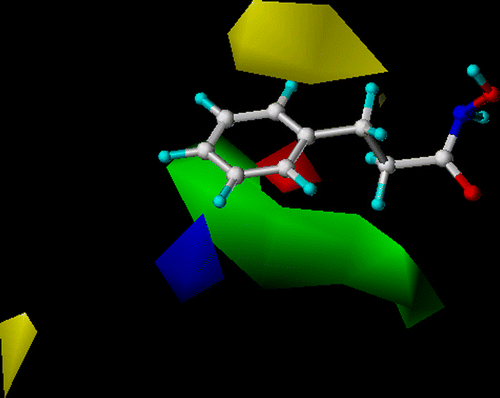
On the electrostatic contour maps () the negative charge favorable red region was found near the C1 of phenyl ring of the reference compound. This indicates that compounds containing electron donating groups at this position will show increased activity. This observation is well consistent with the experimental results, for example compound 2 having proton at this position showed less activity as compare to compounds 3, 4 and 5 which possess electron rich aliphatic chains at this position. These observations are in good agreement with previous published results [Citation31,Citation32], in which it is proved that electronegative groups that can interact favorably with nickel ions of the receptor, will be capable of effectively bind to the active site. One positive charge favored blue isopleths were found near meta position of phenyl ring of the reference compound. This observation is verified by the experimental results as the activity of compound 13 is greater than compound 14 because it contains electron donating group (nitro group) at this position.
CoMSIA contour maps
The steric contour maps from the CoMSIA analysis () are generally in accordance with the CoMFA steric maps (). The contour maps of hydrophobic properties () indicate that hydrophobically favored (yellow) and disfavored (white) regions are around side chain in up and down positions. This observation is in agreement with CoMFA steric contour map (), that shows the steric favorable green and unfavorable yellow regions at the same positions. On the electrostatic contour maps the negative charge favorable region (red) is very close to the CoMFA results. The positive charge favorable blue isopleths were found above alpha carbon of the reference compound. This observation is verified by the experimental results such as the activity of compound 28 is greater than compound 30 because in compound 28 the proton is attached to alpha carbon whereas in compound 30 the electron rich alkyl group is present at this position where negative charge is disfavored. This indicates that more positive charge is favored at this position which also support previously published results [Citation33] in which benzohydroxamic acid at pH 5.0 shows more potent activity than at pH 8.0. This is because of the reason that at acidic pH 5.0 the benzohydroxamic acid is in a positively charged form. In the hydrogen bond donor and acceptor contour maps the hydrogen bond donor favorable (cyan) contour () was found near amido nitrogen and the hydrogen bond acceptor favorable (magenta) contour () was found near carbonyl oxygen of hydroxamic group in most of the compounds. These results highlight the importance of amido nitrogen and carbonyl oxygen as hydrogen bond donor and acceptor respectively. The hydrogen bond donor and acceptor disfavorable regions (purple and red) were observed near hydroxyl oxygen of hydroxamic group ( and ). This indicates that this hydroxyl group is equally important as a hydrogen bond donor and acceptor. These results of hydrogen bond donor and acceptor property are according to the published data [Citation34] which further verified our 3D-QSAR models.
Figure 4. CoMSIA contour plots for steric and electrostatic fields with compound 29 as a reference compound. Sterically favored areas are shown in green while the yellow isopleths depict sterically disfavored areas. Blue isopleths depict areas where positively charged groups increase activity and red areas indicate increase in the activity with negatively charged groups.
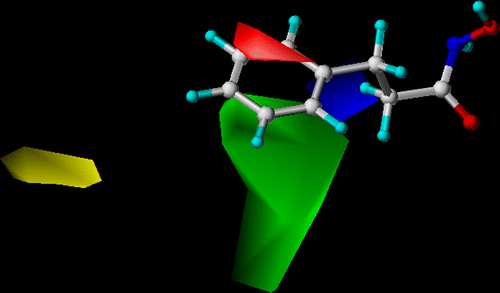
Figure 5. CoMSIA contour plots for hydrophobic interaction with compound 29 as a reference compound. Yellow regions indicate area where hydrophobic groups increase activity, and white regions indicate area where hydrophobic groups decrease activity.
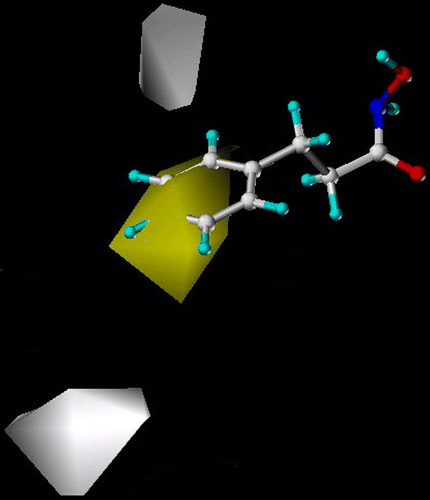
Conclusion
The 3D-QSAR analyses, CoMFA and CoMSIA were used to build statistically significant models with good correlative and predictive power for urease inhibitory activities of the hydroxamic acid derivatives. The robustness of the derived models was verified by the test set. Results of this study may provide an important basis for future drug design studies and synthesis of more potent urease inhibitors.
Acknowledgements
Financial support from Higher Education Commission, Pakistan under the establishment grant is highly acknowledged. We also greatly acknowledge the technical support provided by Professor Bernd M. Rode (University of Innsbruck) during this research.
Declaration of interest: The authors report no conflicts of interest. The authors alone are responsible for the content and writing of the paper.
References
- PA Karplus, MA Pearson, and RP Hausinger. (1997). Acc Chem Res 30:330–337.
- HLT Mobley, and RP Hausinger. (1989). Microbiol Rev 53:85–108.
- JM Bremner, and MJ Krogneier. (1989). Proc Natl Acad Sci USA 86:8185–8188.
- JM Bremner. (1995). Fert Res 42:321–329.
- CM Collins, and SEF D'Orazio. (1993). Mol Microbiol 9:907–913.
- HLT Mobley, MD Island, and RP Hausinger. (1995). Science 59:451–480.
- RL Mulvaney, and JM Bremner. (1981). Soil Biochem 5:153–196.
- LE Zonia, NE Stebbins, and JC Polacco. (1995). Plant Physiol 107:1097–1103.
- K Kobashi, J Hase, and K Uehara. (1962). Biochim Biophys Acta 65:380–383.
- WN Fishbein, PP Carbone, and HD Hochstein. (1965). Nature (London) 208:46–48.
- GC Gale, and IM Atkins. (1969). Arch Int Pharmacodyn Ther 180:289–298. b) Kobashi K, Hase J, Uehara K. Biochem Biophys Acta 1962;62:380-383
- J Hase, and K Kobashi. (1967). J Biochem (Tokyo) 62:293–299.
- K Munakata, K Kobashi, S Takebe, and J Hase. (1980). J Pharmacobiodyn 3:451–456.
- RM Nervig, and S Kaids. (1976). Can J Microbiol 22:544–554.
- IJ Rosenstein, JM Hamilton-Miller, and W Brumfitt. (1981). Infect Immune 32:32–37.
- RL Blakeley, EC Webb, and B Zerner. (1969). Biochemistry 8:1984–1990. b) Wu Z, Zhou X, Zhang W, Xu Z, You X, Haung XJ. Chem Soc Chem Commun 1994;7:813-814
- RD CrammerIII, DE Patterson, and JD Bunce. (1988). J Am Chem Soc 110:5959–5967.
- G Klebe, U Abraham, and T Mietzner. (1994). J Med Chem 37:4130–4146.
- G Klebe, and U Abraham. (1999). J Comput Aided Mol Des 13:1–10.
- M Büohm, J Stürzebecher, and G Klebe. (1999). J Med Chem 42:458–477.
- K Kyoichi, K Kenji, and H Junichi. (1971). Biochem Biophys Acta 227:429–441.
- SYBYL 6.9 Tripos Inc., 1699 Hanley Road, St. Louis, MO 63144.
- M Clark, RD CramerIII, and N van Opdenhosch. (1989). J Comp Chem 10:982–1012.
- SYBYL, ver. 6.5., Tripos Associiates: 1998 St. Louis, MO.
- S Wold, C Albano, WJ Dunn, U Edlund, K Esbensen, P Geludi, S Hellberg, E Johansson, W Lindberg, and M Sjöström. (1984). Chemometrics The Netherlands 250–300.
- WJ Dunn, S Wold, U Edlund, S Hellberg, and J Gasteiger. (1984). Quant Struct Act Relat 3:131–137.
- P Geladi. (1998). J Chemometrics 2:231–246.
- S Wold. (1978). Technometrics 20:397405.
- RD CramerIII, JD Bunce, and DE Patterson. (1988). Quant Struct Act Relat 7:18–25.
- K Kenji, T Suiichi, K Kyoichi, and H Jun'ichi. (1972). Chem Pharm Bull 20:1599–1606.
- H Mishra, AL Parrill, and JS Williamson. (2002). Antimicrob Agents Chemother 46:2913–2918.
- KM Khan, S Iqbal, MA Lodhi, GM Maharvi, Z Ullah, MI Choudhary, Atta-ur-Rahman, and S Perveen. (2004). Bioorg Med Chem 12:1963–1968.
- Y Ito, Y Onoda, S Nadamura, K Tagawa, T Fukushima, Y Sugawara, and O Takaiti. (1993). Jpn J Pharmacol 62:175–181.
- MA Hpearson, LO Michel, RP Hausinger, and PA Karplus. (1997). Biochemistry 36:8164–8172.
